» Jump to recipes using Kale as an ingredient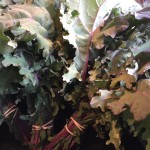
 KALE
KALE

Nothing quite like watching a 3 year-old picking and eating a “kale pop” fresh from the farm.
Kale– (Brassica Family)
Green, blue, red, or purple leaves both flat and curly, which do not form a head. Kale is considered a great source of vitamins and minerals. Kale is a hearty green.
Make sure your kale is washed before use in lukewarm water. After any grit has settled to the bottom, lift the leaves out carefully. If still appears gritty, you can wash again. You can boil, steam, sauté, bake, etc. Kale usually does well with a longer cooking time to bring out any natural sweetness. The center stalk of some kale is tough and can be removed for cooking. Both Green Smoothies prepared with Kale and Kale chips are trendy ways of preparing kale.
It is fine to leave the stems on baby kale but ours is certainly not baby…in fact, some of the leaves could probably break records…the plants are loving the field they are in this year!
To cut out the stem, fold the leaf in half and slice out the stem portion of the vegetable. De-stem several leaves, stack them up and then slice diagonally into one inch wide ribbons.
We tend to eat the stems! But we save them for another dish. And if you are doing that, toss them in a zip-lock bag and place in your fridge. Some of us cut them in little bites and sautee them as a side dish. They are flavorful and good for you and we do not like to see anything go to waste!
Redbor Kale– appropriately named for its red-purple color. This type of kale is edible but is often used for ornamental purposes.
Red Russian Kale– Vibrant purple-green color with flat almost feathered leaves. The center purple stalk is fiberous and can be removed for cooking. The stems can be difficult to chew and swallow and may cause stomach upset.
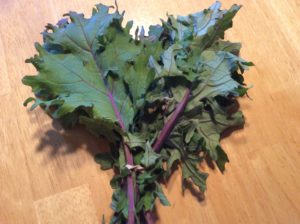
Lacinato Kale– I love this type for its alternative name, Dinosaur kale. Dark blue-green, wrinkly, narrow and flat leaves. This variety has a more delicate, earthy flavor and not as much bitterness.
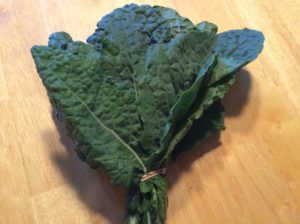
Winterbor or Curly Kale– the most recognizable and most likely variety you are to run into. Tight ruffled leaves and a fiberous center stalk. This type of kale has a peppery and bitter qualities. Younger kale of this variety is more tender.
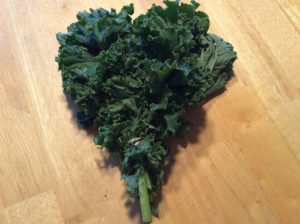
Store dry kale in a losely sealed plastic bag in the refrigerator 5-7 days. Kale also freezes well and actually becomes sweeter after being exposed to frost.
Springdell does not use any preservatives or “smart-fresh” on ANYTHING, so if you toss your greens (lettuce, spinach, kale, chard, etc) into your fridge when you get home, they will wilt. We suggest taking some time when you get home with your weekly share and get stuff put away properly to ensure it is fresh when ready to use. Wash kale, cut if necessary, toss in a zip-lock bag with a wet paper towel.
When you go to use it in a few days or even a week, it will still be FRESH!
Vitamins A, C, K, E, B6, calcium, fiber, antioxidants, selenium, magnesium
—
Overwhelmed with greens in your share? During the influx of seasonal greens, Jess usually starts a pot of boiling water after she gets home. After going over the meal plan for the week, fill a big bowl with ice and water and clean the veggies you’ll be freezing while waiting for the large pot of water to boil. Meanwhile, visit this website from the National Center for Home Preservation or a similar website to be reminded of blanching times for each veggie. Next, send each prepared veggie through the boiling water for it’s allotted time, then into the ice water to stop the cooking process. Next it’s into the colander to drain, then into the freezer bags (or a FoodSaver if you’ve got one). Once the water is boiling, everything moves very quickly, quite like an assembly line. Unless you’re doing a major amount of veggies, you don’t have to change the boiling or blanching water in between veggies.  Though you may be growing weary of the abundance of certain veggies at present, they can definitely be a sight for sore eyes during the winter months!
Though you may be growing weary of the abundance of certain veggies at present, they can definitely be a sight for sore eyes during the winter months!
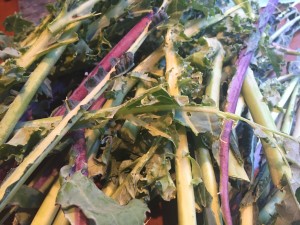
Stems have a delicious home in a batch of kale pesto!
Recipes Using Kale
This one is very flexible in terms of seasonal ingredients. Shredded cheese and tortillas, maybe some sour cream and salsa and you’re good to go! Leave the chicken out for a vegetarian option, and use GF corn tortillas for a gluten-free option.
A super fast smoothie idea from Sarah.
Cream is optional. The potato crust keeps this one in the gluten-free friendly zone and many different potatoes work with this one. If you are not a fan of kale, but are a fan of quiche, this is a good one! I recommend very sharp cheddar cheese, but you can stray easily into new territory with this recipe.











